Have Your Say: How can the commercial interior sector turn our conversation on sustainability into actions? Part 1
At Design Insider we recognise the expertise within commercial interiors and we are proud to instigate conversations which inform, challenge & inspire the people who make our sector thrive.
The response to this month’s question is unprecedented! As a sector we’re clearly ready for action! We’ve published answers in two parts. Enjoy Part 2 here.
Last month we asked Commercial Interior Designers and Suppliers about their key sustainability considerations when addressing demolition and/or installation and discovered that for many re-use is paramount, achieved through a pre-demolition survey. We also learnt that, unsurprisingly, material and product research is vital. This month we are following on from this conversation by asking: How can the commercial interior sector turn our conversation on sustainability into actions?
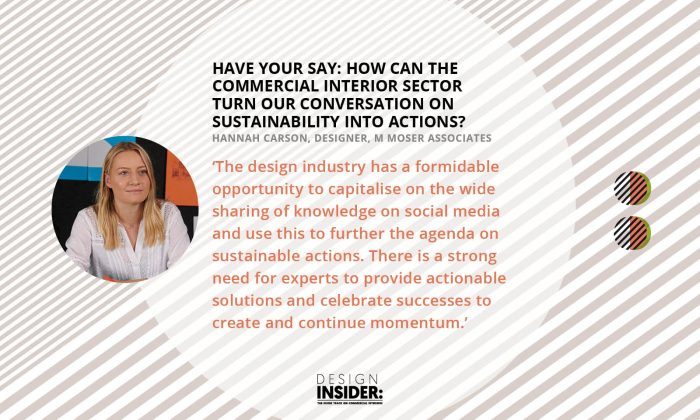
‘The design industry has a formidable opportunity to capitalise on the wide sharing of knowledge on social media and use this to further the agenda on sustainable actions. There is a strong need for experts to provide actionable solutions and celebrate successes to create and continue momentum.
Sharing beyond industry talks and webinars means information will circulate more readily, reaching directors to juniors; short, impactful recommendations are easier to share across media platforms, available beyond those able to join daytime talks and cater to multiple/future generations. Understanding how to implement sustainability solutions within the design industry will become clearer once experts provide concise takeaways in engaging formats, such as digestible soundbite clips which reach all levels.
We look forward to sharing more ourselves, like this highlights clip from a recent decarbonisation roundtable: https://www.mmoser.com/news/jeni-durksen-decarbonisation-roundtable/ Industry leaders make larger impacts more efficiently, by adopting current and accessible ways of communicating knowledge.’
Hannah Carson, Designer, M Moser Associates
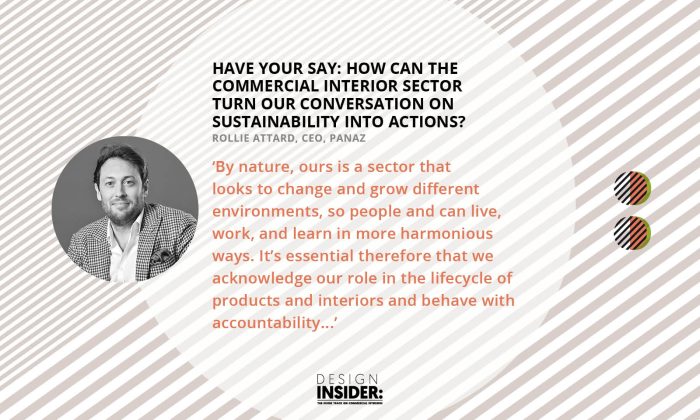
‘Questions about sustainability are becoming more frequent in conversations between suppliers and designers as the need for minimising the negative impacts of climate change increases and meeting the government’s 2050 Net Zero deadline approaches.
By having open and proactive discussions from the outset of a project, suppliers and designers can collaborate on schemes that place sustainability at the heart of them. At Panaz, we consider all aspects of our environmental impact by using chemical-free antimicrobial and FR solutions and a digital printing process, avoiding the use of harmful chemicals. Through innovation, we provide designers with environmentally conscious products that do not compromise on design or design technical standards.
Last year we launched EcoTwist, a printable basecloth and matching plains collection made from 100% recycled PET drinks bottles, created through a manufacturing process less water and energy-intensive than virgin polyester. Due to the product’s composition, it can be recycled at end-of-life. So designers can achieve great design without compromise, whilst minimising the scheme’s environmental impact.
By nature, ours is a sector that looks to change and grow different environments, so people and can live, work, and learn in more harmonious ways. It’s essential therefore that we acknowledge our role in the lifecycle of products and interiors and behave with accountability – through designing for longevity and integrating circular economy principles into the creative process.’
Rollie Attard, CEO, Panaz

‘Sustainability within the commercial interior sector is moving in the right direction, but we could all do more. If the only products available were sustainable and ethical, it would make creating green projects more accessible and commonplace. So, suppliers must develop a broader range of sustainable products at a reasonable price point to fit within the budget and scope of client projects, and designers must prioritise specifying these products.
All designers should have access to a design library exclusively listing sustainable products. Finally, we must be proactive and take ownership in educating ourselves on new technologies and products promoting green design to be incorporated into projects. We are all in this together.’
Alessandro Tessari, Design Associate, AD Associates
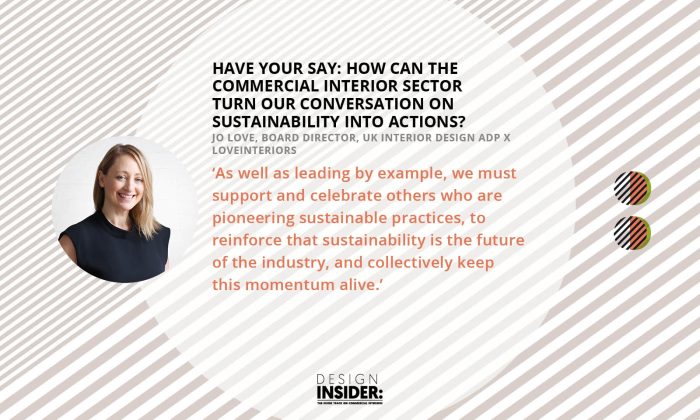
‘When we refurbish, and redesign, we need to treat anything that we remove or replace as of value, and see through that it is recycled, reused, or disposed responsibly. When we source and specify, we must go that one step further to interrogate products and their environmental footprint, and be mindful to work with companies who share our values. And as well as leading by example, we must support and celebrate others who are pioneering sustainable practices, to reinforce that sustainability is the future of the industry, and collectively keep this momentum alive.’
Jo Love, Board Director, UK Interior Design adp x LOVEINTERIORS

‘We need to evolve material and product passporting much further. This will create more transparency on the part of manufacturers, designers and clients, all of which will make circularity more intuitive. A centralised digital database for both manufacturers and building managers would encourage the take or buy back of unwanted or damaged products. Even if an original manufacturer isn’t involved in the refurb, all the information needed for the next part of a product’s journey would be held within the digital passport.
It’s relatively early days, but I believe if passporting is used effectively we can achieve great results on waste reduction and see a bigger shift towards reused and refurbished products – creating momentum designers need in order to push harder with clients. Passporting needs to become standard practice in order to accomplish tangible sustainability results.’
Amy Roberts, Sustainability Researcher & Interior Designer, align
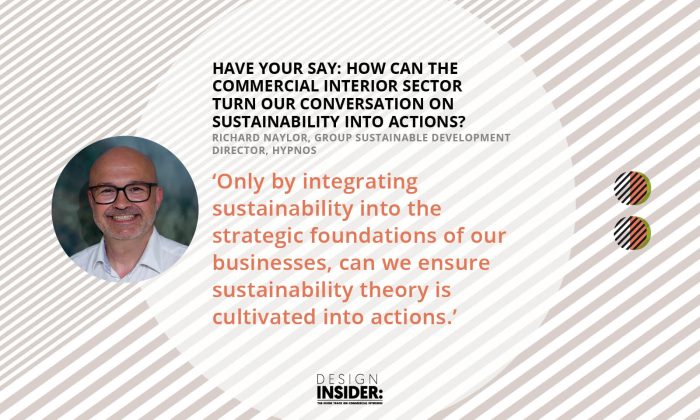
‘Only by integrating sustainability into the strategic foundations of our businesses, can we ensure sustainability theory is cultivated into actions. As I near the end of my MSc in sustainability, I believe the best advice on how to turn sustainability theory into actions starts with the following principles:
- Purpose: ensure that sustainable development is imbedded in your business purpose.
- Leadership: the leadership culture of the business needs to embrace sustainability and allow for top-down autonomy, as this allows sustainability focused decisions to be taken. So, have a dedicated ESG/Sustainability focused Board member – ideally this should be a focused role and not a functional add-on to another Board position such as the Finance.
- Knowledge: it is vital that businesses understand the consequences of their actions. For example, when selecting a new material for a product, it is important to understand the impact that material has during its production and all the way through the value chain to end of life and recycling/circular potential. Many businesses do not research this enough, so are in danger of misinforming consumers or ‘greenwashing’ – ignorance is not a defence in this regard.
- Strategy: your sustainability/ESG strategy need to be clear with goals and funding that allow impact actions to be made socially, economically, and environmentally.
- Grand challenges: creating a business model that recognises grand challenges such a biodiversity loss and climate change is essential.’
Richard Naylor, Group Sustainable Development Director, Hypnos
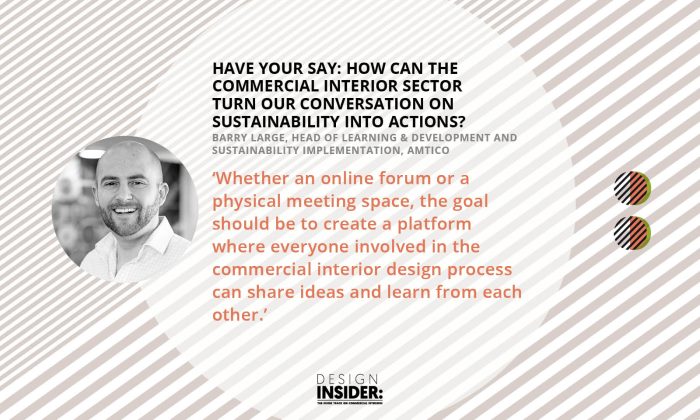
‘The next step in the sustainable conversation is to increase collaboration between all parties involved in the commercial interior design process – this includes designers, contractors, manufacturers and clients. Whether an online forum or a physical meeting space, the goal should be to create a platform where everyone involved in the commercial interior design process can share ideas and learn from each other.
At Amtico, we started turning our conversations into action by introducing bio-attributed LVT flooring made from renewable materials. As one company, we can only make so much of a difference, but together we can create a more sustainable future for our industry.’
Barry Large, Head of Learning & Development and Sustainability Implementation, Amtico

‘Manufacturers must build sustainability into everything they create. Not only does this demonstrate commitment, but it ultimately helps specifiers make an easier and more responsible choice. We become overwhelmed by labels, certifications, or ingredients, and begin to lose sight of sustainability in the process.
Since most manufacturers can’t make a switch overnight it’s all about mindful selections, step-by-step, as products improve. Sustainability must be part of every project. While we can discuss a perfect future state, today specifiers can act by selecting manufacturers that are committed for the long haul, actively evolving with technologies, and are putting forth their best options. Let’s stop striving for perfection, this is a journey!
At Ultrafabrics, our materials provide sustainability without sacrifice. We are including rapidly renewable or recycled resources across our portfolio by 2025; over 50% of our fabrics already include these ingredients. We are building-in sustainability to help ease the selection process.’
Nicole Meier, Director of Branding, Ultrafabrics
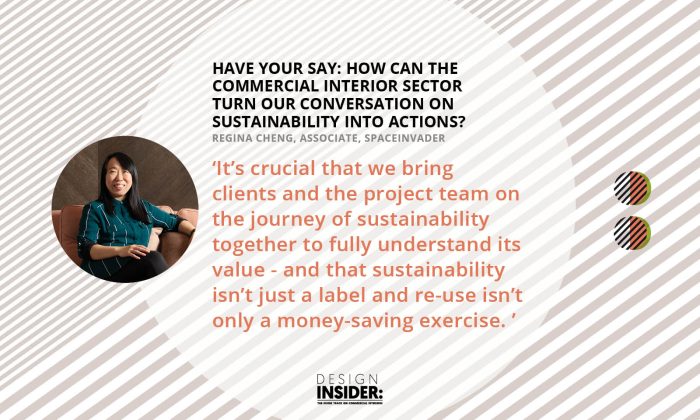
‘It’s crucial that we bring clients and the project team on the journey of sustainability together to fully understand its value – and that sustainability isn’t just a label and re-use isn’t only a money-saving exercise. At the core of this is commitment, transparency and honesty, as blurb is confusing and slows things down. We can only help educate and share knowledge with the team if the information that we get from suppliers and manufacturers is clear and simple to understand. And we can only make progress and take action with reliable information.’
Regina Cheng, Associate, SpaceInvader
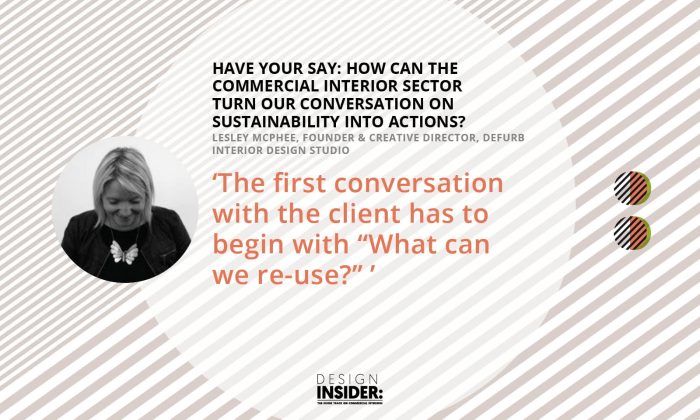
‘I think the first conversation with the client has to begin with “What can we re-use?” whilst walking around site for the first time. In last 3 projects we have been able to retain and re use carpets, partitioning and ceilings along with furniture. One particular project the client’s stage designers re purposed ply meeting booths to fit their new office layout along with set pieces of furniture and artwork and anything left over was donated to local charities. We also educate our clients on sustainable materials and suppliers and try to stay within a certain mile radius of the project to reduce the carbon footprint. Running Design workshops, at the beginning lets everyone who will use the space have a voice, and come up with initiatives for sustainability on their project.’
Lesley McPhee, Founder & Creative Director, Defurb Interior Design Studio
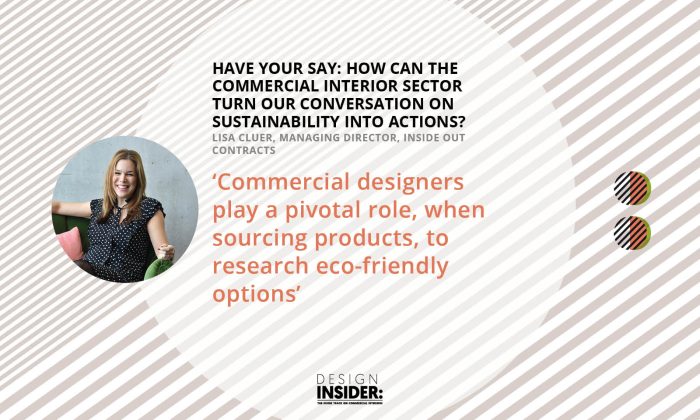
‘Conversation on sustainability is being turned into action by many furniture creators all around the world. We can see each year, more and more innovative products being created with a focus on sustainable materials, production and delivery methods. These products are increasingly being competitive on price. Commercial Interiors are already being created with products made of sustainable materials such as rattan, FSC approved wood or recycled materials. However, to increase this trend further, it is important to keep the awareness and momentum going, so that conversation keeps being turned into action.
Commercial designers play a pivotal role, when sourcing products, to research eco-friendly options. At Inside Out, products can be easily found on our website by ticking the ‘sustainable’ materials option or by visiting our sustainability page, where we highlight the latest sustainable products.’
Lisa Cluer, Managing Director, Inside Out Contracts
For our July Have Your Say article we are asking: What is the most extraordinary thing happening in the hotel sector right now?
We would love to publish your opinion, please email your answer (50-150 words), name, title, company and portrait to alys@designinsiderlive.com Copy deadline 20th June.




